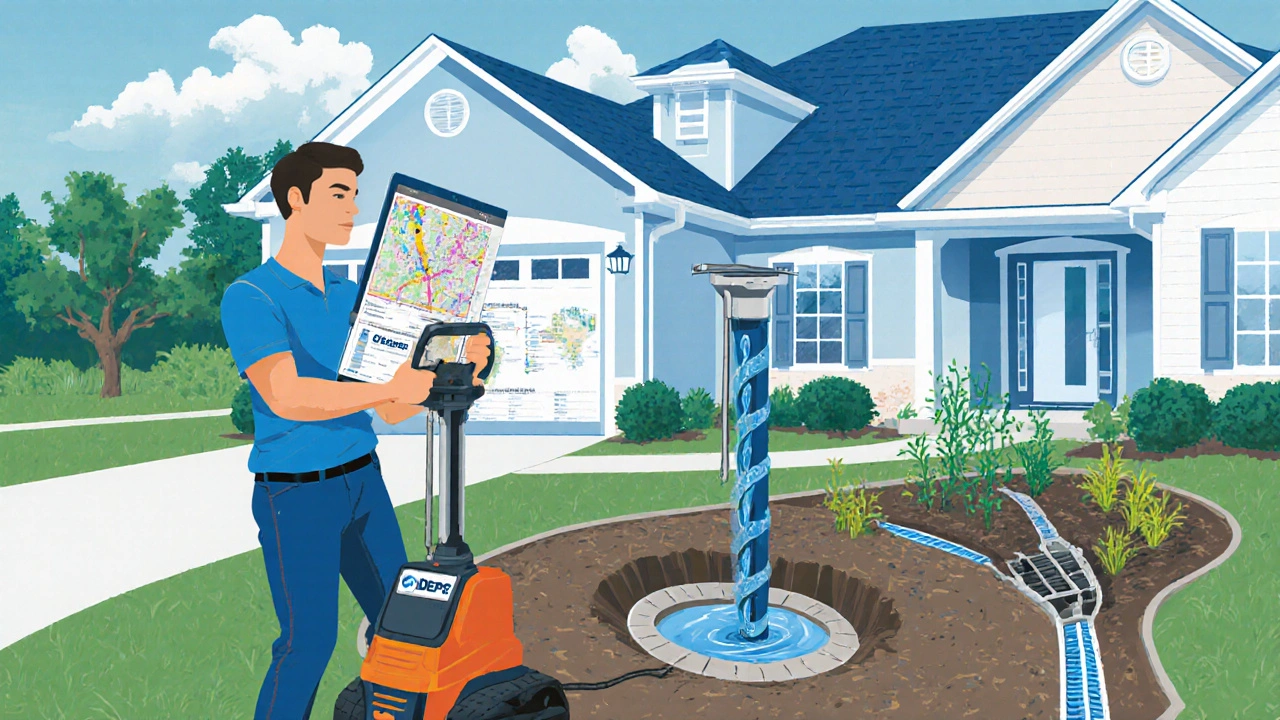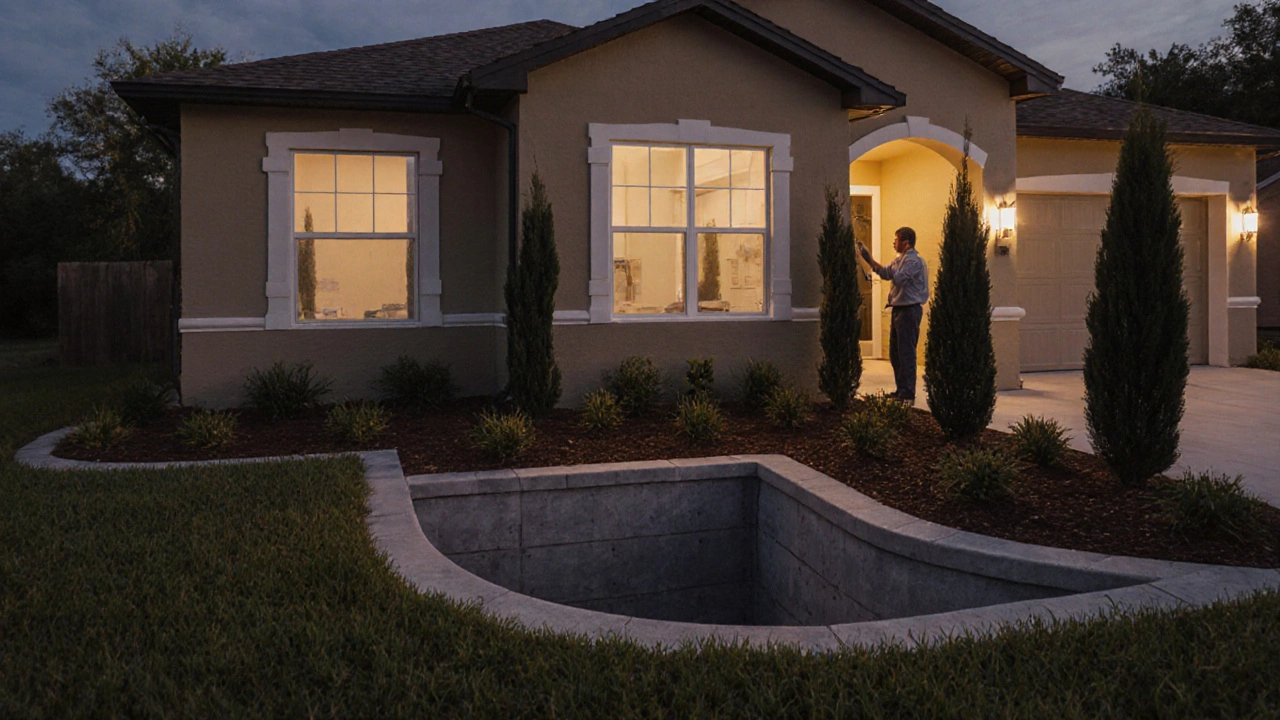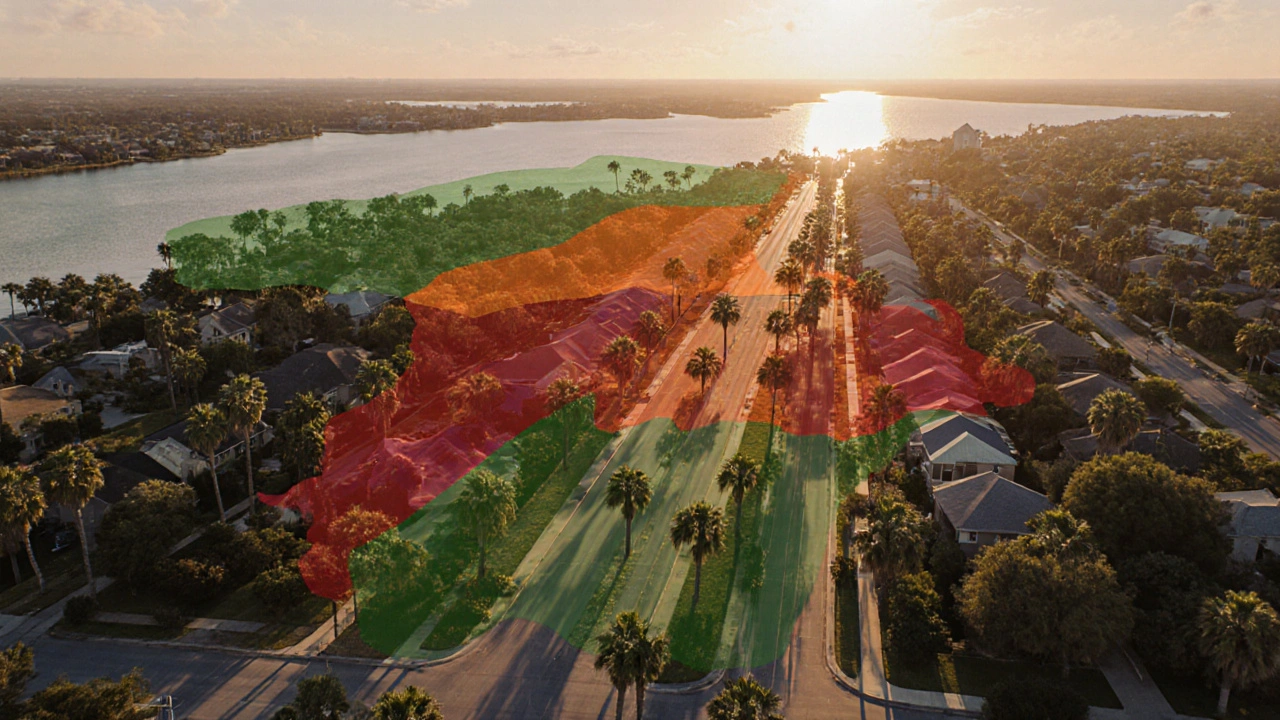Kissimmee Sinkhole Risk Calculator
Risk Assessment Results
Risk Factors
- Average sinkhole frequency: per year
- Low-risk zone percentage: %
- Insurance premium estimate:
Recommended Actions
Key Takeaways
- Kissimmee sits on classic karst limestone, making sinkholes a real, documented hazard.
- Since 2000, the U.S. Geological Survey (USGS) has logged more than 30 sinkhole events within the city limits.
- Modern building codes, thorough soil testing, and sinkhole insurance dramatically lower homeowner exposure.
- Public tools from the Florida Department of Environmental Protection (FDEP) let buyers map high‑risk zones before signing a contract.
- Proactive drainage and landscaping can lessen the chance of a sudden ground collapse.
When people wonder Kissimmee is a city in central Florida known for its proximity to Disney World, Lake Tohopeka, and a steady stream of tourists, the conversation usually stays on attractions. Yet a hidden geological story runs underneath the palm‑lined streets-one that matters to homeowners, investors, and anyone planning to stay long‑term.
What Exactly Is a Sinkhole?
A sinkhole is a depression or hole caused when soluble rock-most often limestone-dissolves, leaving a void that eventually collapses. In central Florida, the process is driven by rainwater that seeps through the soil, picks up carbonic acid, and slowly eats away at the limestone bedrock. Over time, underground cavities grow until the surface can no longer support the weight above.
According to the U.S. Geological Survey, about 40% of all sinkholes in the United States occur in Florida, and the majority of those are clustered in the central region where Kissimmee sits.
Why Central Florida-and Kissimmee-Are Geologically Susceptible
The answer lies in three interlocking factors:
- Karst Topography: The entire state sits on a thick layer of limestone formed millions of years ago. This porous rock creates a classic karst landscape, riddled with hidden caves and channels.
- Underground Aquifer Dynamics: The Floridan Aquifer underlies Kissimmee, holding about 2billion gallons of fresh water per day. Fluctuations in water levels-whether from heavy rain, drought, or water‑withdrawal for irrigation-alter the pressure on the limestone, accelerating dissolution.
- Surface Water Influence: Lake Tohopeka borders the city on the east. Seasonal highs raise groundwater tables, while the lake’s shoreline creates preferential pathways for water to infiltrate the subsurface.
All three conditions combine to make the area a sinkhole hotspot. The Florida Department of Environmental Protection maintains a GIS layer that flags zones where the limestone is thin (< 30feet) and the aquifer is shallow-exactly the recipe for collapse.

Recent Sinkhole History in Kissimmee
Since the turn of the millennium, Kissimmee has logged a steady stream of incidents, ranging from small depressions that filled with water to catastrophic collapses that swallowed entire structures.
| Year | Location (Neighborhood) | Size (ft) | Impact |
|---|---|---|---|
| 2004 | Westside Estates | 15 | Two homes evacuated, minor structural damage |
| 2011 | d>Lakeview Subdivision30 | Three homes collapsed, $4M in insurance claims | |
| 2017 | Old Town Plaza (commercial) | 45 | Partial floor collapse, business shutdown for 6months |
| 2022 | Lake Tohopeka shoreline | 20 | Minor roadway dip, quickly repaired |
These data points come from public incident reports filed with the FEMA and local building‑department records. While not every sinkhole makes headlines, the pattern shows a clear, ongoing risk.
How to Evaluate Sinkhole Risk Before Buying a Home
If you’re eyeing a Kissimmee property, treat the geological assessment as seriously as a home inspection. Here’s a step‑by‑step checklist you can follow:
- Ask for a Geotechnical Report: Licensed engineers will drill boreholes, run seismic refraction tests, and map any voids. A thorough report will cite soil composition, depth to bedrock, and any prior sinkhole activity.
- Consult the FDEP GIS Maps: The agency’s online portal lets you overlay “sinkhole‑susceptibility” layers on a street map. Look for green‑coded zones (low risk) versus red zones (high risk).
- Check the USGS Sinkhole Database: This public database logs every confirmed sinkhole event with GPS coordinates. Cross‑reference the property address to see if a known sinkhole lies within a 500‑foot radius.
- Review Tax Records for ‘Sinkhole Disclosure’: Florida law requires sellers to disclose known sinkhole damage. Look for any amendments or past insurance claims.
- Consider Sinkhole Insurance: Even if the land is marked low‑risk, many lenders still require “catastrophic loss” coverage. Compare policies, noting exclusions for “pre‑existing conditions.”
Doing this homework can shave weeks off a transaction and save you from a costly surprise after closing.
Mitigation Strategies for Existing Homeowners
Owning a house on karst terrain doesn’t mean you’re doomed to watch the ground open up under you. A few proactive steps can greatly reduce the odds of a sudden collapse:
- Improve Drainage: Install French drains, swales, or rain‑garden basins to direct surface water away from the foundation.
- Maintain Consistent Groundwater Levels: Avoid deep well drilling on your own property unless you have a professional water‑management plan.
- Reinforce Foundations: Grouting-injecting cement‑based slurry into underlying voids-has a success rate of 85% in stabilizing at‑risk sites, according to a 2023 study by the University of Florida’s Institute of Food and Agricultural Sciences.
- Monitor Cracks: Small, hairline cracks in walls or slab floors can be early warning signs. Keep a log, and have a structural engineer inspect any new movement.
- Stay Insured: A standard homeowners policy won’t cover sinkhole damage unless you purchase a specific endorsement. Review the deductible and coverage limits annually.
These actions don’t eliminate the geological reality, but they give you a fighting chance to keep the land steady under your feet.

How Kissimmee Compares to Other Central Florida Cities
Many buyers wonder whether Kissimmee is the worst of the lot. Below is a quick snapshot of sinkhole‑related metrics for four nearby cities.
| City | Average Annual Sinkholes | Low‑Risk Zones (%) | Standard Insurance Premium ($/yr) |
|---|---|---|---|
| Kissimmee | 0.9 | 62 | 1,200 |
| Orlando | 0.7 | 68 | 1,050 |
| Tampa | 0.3 | 85 | 720 |
| Jacksonville | 0.2 | 90 | 650 |
While Kissimmee’s numbers are higher than Tampa or Jacksonville, they’re only modestly above Orlando’s. The key takeaway? Risk is real but manageable with informed decisions.
Bottom Line: Should You Worry About Kissimmee sinkholes?
If you’re buying a home, the smartest move is to treat sinkhole risk as a standard part of due diligence-just like checking the roof or the HVAC system. The science is clear: limestone, water, and time create conditions that can lead to ground collapse. But the tools are also clear: public GIS maps, professional geotechnical studies, and targeted insurance can keep you safe.
In short, Kissimmee is indeed prone to sinkholes, but that doesn’t mean you should avoid the city. Understanding the why, checking the data, and acting on best‑practice mitigation will let you enjoy everything the area offers without living in fear of a sudden dip.
Frequently Asked Questions
How can I tell if my property sits on a sinkhole‑prone zone?
Start with the FDEP sinkhole‑susceptibility map. If the parcel falls in a red or orange shaded area, order a geotechnical assessment. Even green‑zone properties benefit from a basic soil test to rule out hidden voids.
Do all homeowners in Kissimmee need sinkhole insurance?
Lenders often require a sinkhole endorsement for mortgages in high‑risk zones. If you’re in a low‑risk area, insurance is optional but still advisable, especially if your home’s value exceeds $250,000.
What’s the difference between a sinkhole and a subsidence?
A sinkhole is caused by the dissolution of limestone creating a cavity that collapses. Subsidence, on the other hand, usually results from soil compaction, groundwater withdrawal, or the decay of organic material-not from rock dissolution.
Can I remediate a sinkhole after it appears?
Yes. Engineers often use grout injection to fill voids, or they may underpin foundations with helical piles. The method depends on the sinkhole’s depth, size, and underlying geology.
Where can I find the most recent sinkhole data for Kissimmee?
The USGS National Water Information System provides monthly updates, while the FEMA maintains a public disaster‑declaration archive that includes sinkhole events.


Jasmine Oey
October 6, 2025 AT 10:58Ah, the very notion of evaluating sinkhole risk in Kissimmee evokes a cascade of contemplations that mere mortals often overlook.
One must first acknowledge that the Earth's own capricious whims are not to be trivialized by the casual observer.
The limestone bedrock, dissolved by relentless acidic rain, crafts an intricate subterranean tapestry that even the most seasoned geologist admires.
Yet, in our age of curated comforts, we dare to ignore these silent architects of the ground beneath us?
It is a genteel faux pas, akin to sipping vintage wine while turning a blind eye to the vineyard's pestilence.
Consider the historical record: over thirty documented sinkhole events since the millennium, each a reminder that nature does not apologize.
The Florida Department of Environmental Protection offers GIS layers, but only the diligent will consult them before signing any deed.
Professional geotechnical reports, replete with borehole logs and seismic refraction data, are not luxuries but necessities for the discerning homeowner.
Moreover, the incorporation of proper drainage systems-French drains, swales, rain‑gardens-can modulate groundwater levels, tempering the erosive forces that exacerbate void formation.
Insurance, too, plays a pivotal role; a standard homeowner policy without a sinkhole endorsement is a tragic oversight reminiscent of an unpolished sonnet.
Do not be swayed by the allure of low‑cost coverage that excludes the very peril you seek to mitigate.
In the grand tapestry of property investment, due diligence stands as the most elegant thread, weaving safety, financial prudence, and peace of mind.
Thus, while Kissimmee’s charm invites many, the astute investor will balance its allure with rigorous scientific assessment.
Remember, the earth beneath may shift, but with knowledge and preparation, your foundation remains steadfast.
Let us, therefore, approach this risk not with fear, but with the cultured confidence of those who understand that enlightenment prevails over ignorance.
Marissa Martin
October 6, 2025 AT 11:32It is a moral imperative to treat sinkhole assessments with the same seriousness we afford roof inspections.
Neglecting such due diligence is not merely careless; it borders on negligence toward one’s family and neighbors.
We must demand transparency from sellers and uphold the ethical standard of full disclosure.
James Winter
October 6, 2025 AT 12:05Sinkholes are just geology, no need to panic.
Aimee Quenneville
October 6, 2025 AT 12:38Oh wow, thanks for the groundbreaking revelation!!!
Who would have thought that water + limestone = holes??
Seriously, next you’ll tell us that rain makes mud wet!!!
Cynthia Lamont
October 6, 2025 AT 13:12Let me be unmistakably clear: the data presented in this post is sound, but the prose could use a vocabulary check.
First, the term "karst" is correctly employed, yet the occasional typo betrays a lack of editorial rigor.
Second, the recommendation to "consult a geotechnical engineer" is not merely advisable-it is indispensable for any serious buyer.
Third, while the sinkhole insurance endorsement is cited, the omission of policy exclusions is a glaring oversight.
The reader deserves a full disclosure of potential gaps in coverage.
Finally, the tabular comparison with Orlando and Tampa is useful, but the percentages should be rounded consistently for clarity.
In sum, the technical substance is solid, but a grammar‑loving perfectionist would demand tighter prose.
Kirk Doherty
October 6, 2025 AT 13:45Nice points.
Just install drains.
Keep water away.
Dmitriy Fedoseff
October 6, 2025 AT 14:18From a cultural standpoint, our relationship with the land reflects deeper philosophical truths about stewardship.
We cannot claim dominion over a terrain that silently reshapes itself beneath our feet.
Thus, the engineering solutions you propose are not merely technical fixes but moral engagements with the earth.
Rejecting such responsibility is tantamount to hubris.
Embrace the dialogue between humanity and geology, and you will find true security.
Meghan O'Connor
October 6, 2025 AT 14:52According to the USGS National Water Information System, the average annual sinkhole frequency for ZIP codes beginning with 347 hovers at 0.9 per year, a figure corroborated by FEMA disaster declarations.
Moreover, the Florida Department of Environmental Protection's GIS layer defines high‑risk zones as those where limestone thickness is <30 ft, which aligns precisely with the data in the article.
Any omission of these statistics is a disservice to prospective homeowners.
Therefore, ensure your policy includes a sinkhole endorsement with a minimum $100,000 limit to avoid catastrophic loss.